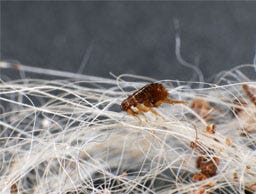What is Flea Allergy Dermatitis and How to Treat it
Flea allergy dermatitis is an allergic reaction that some pets experience in response to flea bites during an infestation. This allergic response can be very uncomfortable for your pet, and you may notice signs such as:
- Itching
- Inflamed skin
- Restlessness
- Loss of fur
- Weeping patches of skin
While some of these symptoms might seem like just the signs of your pet having fleas, a pet’s reaction to flea bites alone is typically just mild skin irritation. This is why it’s important to look out for other signs of flea infestations in pets so you can catch them as early as possible.
In pets with a flea allergy, however, their body’s response to a flea bite is much more severe and sometimes a single bite is enough to cause a drastic allergic reaction. If your pet is experiencing any of the above symptoms, with or without the presence of fleas, it’s important you consult your vet for a thorough diagnosis to ensure there are no other skin conditions that might be the cause.
What Causes Flea Allergy Dermatitis?
Flea allergy dermatitis, or flea bite sensitivity, is an allergic reaction in your pet to flea bites, or more specifically, to the proteins or antigens present in the flea’s saliva.
For a flea to survive, it needs to consume blood from your pet, which requires it to bite the skin. In doing so, the flea will usually deposit some of their saliva into the bite site, which can then enter your pet’s body. If your pet has an allergy, and the allergen (in this case, the flea saliva) enters the body, your pet’s immune system will overreact and produce antibodies to try and fight off the allergen. It’s this immune response that causes your pet to experience symptoms, including:
- Intense itching
- Over-grooming
- Chewing the skin
- Hair loss
- Open scabs or sores
Scabs or sores can open the door for secondary bacterial infections, which can cause your pet unnecessary stress or damage if left untreated, so make sure you keep their skin clean and free of bacteria with a skin-friendly antiseptic, like these easy-to-use DOUXO® S3 PYO Antiseptic Cleansing Pads.
Is Flea Allergy Dermatitis Contagious?
No, flea allergy dermatitis is not contagious as it's not a virus or disease but an allergic reaction, and allergies are not contagious. Whether your pet has an allergic reaction to flea bites depends on their immune system. It's more important to remember that the cause of flea allergy dermatitis is fleas, and they are more than happy to jump from one pet to another in a blink!
Whether you have one pet in your or more, always ensure you are up to date with routine flea treatments to prevent infestations from taking hold.
How to Treat Flea Allergy Dermatitis
The key step when treating any allergic reaction is determining and removing the allergen. In cases of flea allergy dermatitis, this means removing all fleas from your pet and their environment. This can be arduous if the infestation is left too long or not properly managed the first time around. Remember, it only takes one flea bite to cause an allergic reaction, so be vigilant and ensure you stay on top of your pet's routine flea treatments. We'd recommend choosing a treatment like Advantage Spot-On flea treatment that kills fleas through contact, meaning they won't even get the chance to bite your pet. Make sure to treat all the pets in your home, not just those suffering from flea allergies.
You should also be sure to treat your home with a household spray like Indorex® Defence Household Flea Spray to tackle the fleas that may have burrowed into your carpets to efficiently break the flea lifecycle and prevent re-infestation. You can shop our complete range of flea treatments and other parasite prevenatives below.
How to Soothe Flea Allergy Dermatitis in Dogs
Once treated with an appropriate dog flea treatment, it may still take some time for your dog’s symptoms to clear up. In the meantime, you can soothe your dog’s allergy symptoms by:
- Bathing them in a hypoallergenic shampoo like the DOUXO® S3 CALM Shampoo.
- Providing supplements high in fatty acids to promote skin and coat health, such as the YuMOVE® Skin & Coat Care Itching for Dogs.
- Speaking with your vet about suitable antihistamines or browse our range of dog allergy treatments.
How to Soothe Flea Allergy Dermatitis in Cats
As we’ve mentioned above, the first step to treating a cat for flea allergy dermatitis is to get rid of any and all fleas by treating them with a cat flea treatment. It may take some time for your pet’s symptoms to die down after this, but you can soothe your cat’s symptoms by:
- Using bathe-free cleansing and hydrating products like the DOUXO® S3 CALM Leave-On Mousse.
- Introducing omega-rich supplements like COATEX® Essential Fatty Acid Skin and Coat Supplement to help nourish and rebuild your cat’s skin and coat.
- Speaking with your vet about suitable antihistamines or browse our range of cat allergy treatments.
If your pet is still not showing signs of improvement after a couple of weeks, consult with your vet in case there are other allergens or skin conditions that may be causing your pet's symptoms.
Skin conditions in pets can be a struggle to manage, and the discomfort they cause can be stressful for your pet. Remember to remain proactive with your pet’s routine healthcare treatments, provide them with additional nutritional support if needed, and never be afraid to speak with your vet to really get to the bottom of what's making them itch! If you're looking to give your pet's skin or coat a little added boost, then check out our complete range of skin and coat care products, including medicated shampoos, grooming essentials, and more!
This post is an opinion and should only be used as a guide. You should discuss any changes to your pet’s care or lifestyle thoroughly with your vet before starting any program or treatment.































